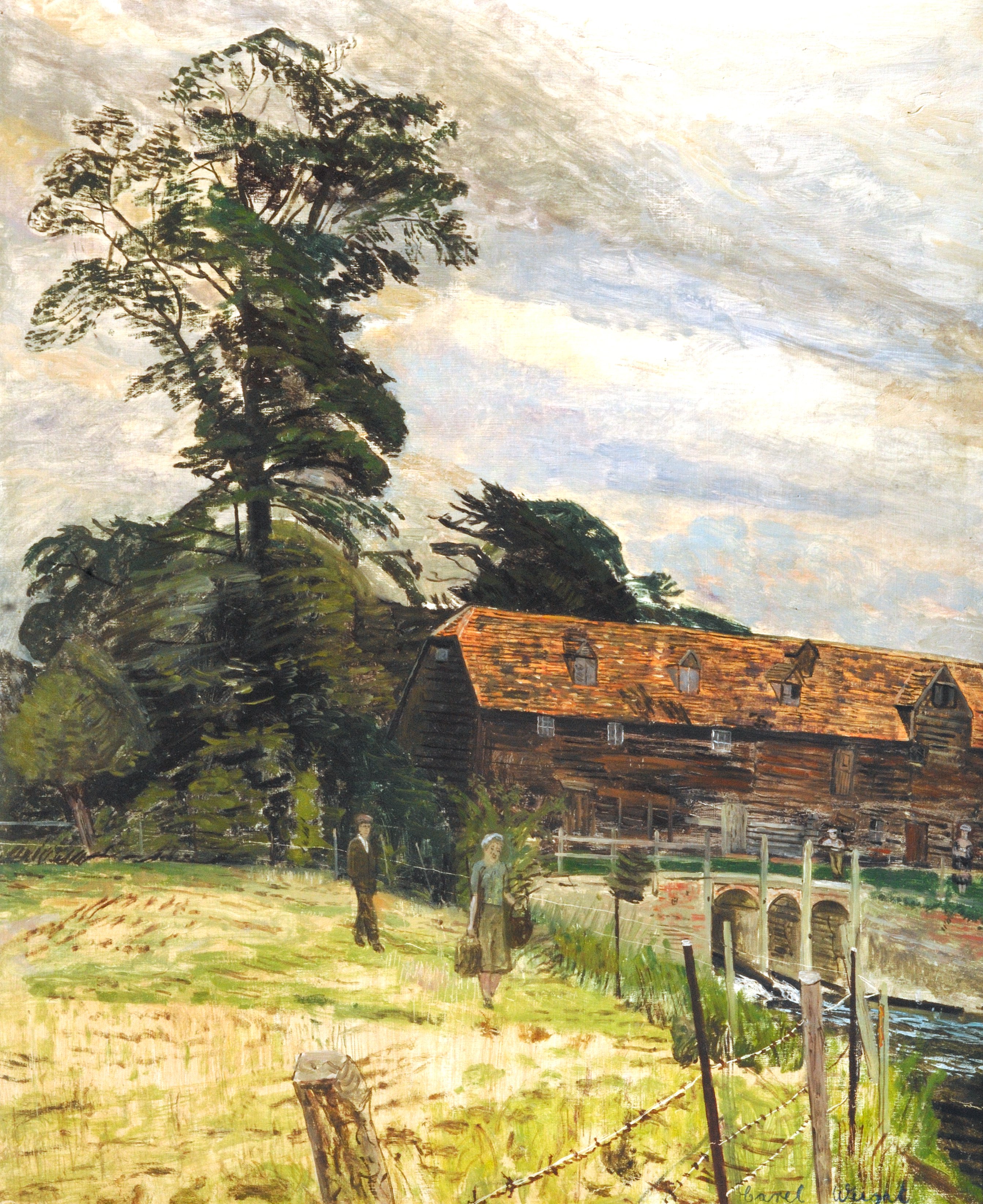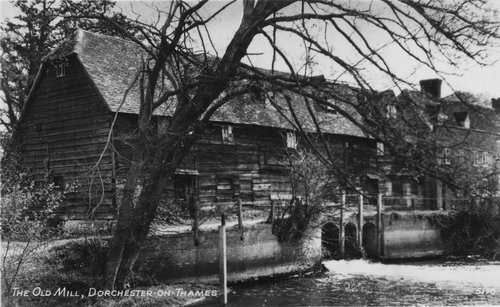15. Overy Mill, by Carel Victor Morlais Weight
 Carel Victor Morlais Weight, Overy Mill, oil, mid-20th century, H 74.9 x W 62.2 cm
Carel Victor Morlais Weight, Overy Mill, oil, mid-20th century, H 74.9 x W 62.2 cm
A first glance at Overy Mill by Carel
Victor Morlais Weight (1908-1997) might suggest that this is a
piece of mid-twentieth century neo-Romanticism – a nostalgic vision of the eighteenth-century
weatherboarded timber-framed mill with old plain-tile roof. The subject would
fit this inclination: there have been mills at Dorchester-on-Thames since the eleventh
century, set amongst the meadows and trees of Oxfordshire (in fact, on land
owned by St John’s from 1874 until the late twentieth century) and overlooking
the River Thames. But this reading of the painting doesn’t hold for very long.
For one thing, the barbed-wire fence that slices through the foreground
disrupts any sense of pastoral, and the mill itself is decentred both by the
figures and by the slanting angle at which it – and the horizon and clouds are
set. This is typical of Weight’s work, in which the mid to background is often
set as if sliding away from the viewer.
It is the figures, however, that add
psychological intensity to the scene. There are four figures in the scene, two
to the right in front of the mill itself, one seated and one standing. These
have the effect of changing the setting from isolated mill to a beauty spot
frequented by visitors. But it is the couple standing in the field, separated
from the river and buildings by the barbed wire that epitomise the kind of
uncanny presence Weight evoked in his paintings. Painted in pale tones so that
initially they are almost absorbed by their surroundings, it is unclear if
‘couple’ is even the right word. There is a woman walking across the field
holding a small case and a black handbag. Where she is going is confused; the
field ends at the river bank with the barbed wire. The case is incongruous too.
And she is followed by, or perhaps simply in the proximity of, a man. He is
walking more casually, his hands in his pockets. I am inclined to read him as
following her, but in no hurry to invade the woman’s reverie, and the meeting
or pursuit – in part shaped by the pale colours – is not a happy one. This,
again, is typical of Weight’s work in which relationships are complicated and
estrangement is pictured in suburban gardens (see The World We Live In, 1970-73)
or rural idylls (see Young Lovers, undated).
Weight once declared that 'Even when I paint a landscape out of doors, and I say I'm not going to put any
figures in; when I get back to the studio I always paint in figures; it would
be too lonely without people'. Ironically, however, it is often the figures
that introduce a new loneliness, a complex welter of emotional
disconnectedness. ‘I think love and all that
sort of thing is rather superficial.’ Weight said in a late interview: ‘You can
love people, but it doesn't bring you any closer to them.’
Weight
is a curious painter – highly prolific and a revered teacher at the Royal
College of Art (he was Professor of Painting there from 1957 to 1973). However
his own work has been somewhat overshadowed by the more exuberant avantgarde
work of his students, who included the likes of David Hockney. Weight himself
trained at the Hammersmith School of Art, joining in 1926, and was initially
taught by James Bateman, who himself had been taught by the highly influential
Tonks at the Slade and whose instruction was deeply classical – his approach to
composition was largely formed around an analysis of Piero della Francesca.
Whilst Weight enjoyed this period of his training, he resisted Bateman’s
emphasis upon realism and when he moved to Goldsmiths, Weight pursued a far
more imaginative approach to painting.
During
the Second World War, Weight was briefly on active service before Kenneth Clark
appointed him an official war artist. Weight’s work during this period is a
haunting mixture of war and domesticity. The War Office censored one of his
paintings, which showed passengers fleeing from a bombed bus, on the grounds
that it depicted a state of public panic. ‘Haunting’ is right, as many of
Weight’s figures in his post-war work are ghosts, painted thinly amidst more
solid figures and representing, amongst other things, a period marked by a
widely-felt sense of loss. Weight’s
work has a penetrating narrative force, and yet it is narration that comes
about through presence and the emotive work of the brush as much as from the
positioning and expressions of the figures. Returning to Overy Mill, the passivity of the figures is countered to an extent
by the rapid marks that make up the trees – there is feeling here, but it is
contained, and the brutality of the barbed-wire that cuts through the
composition seems to narrate the dislocation we read in the space between the
two main figures.
Weight’s
work has a penetrating narrative force, and yet it is narration that comes
about through presence and the emotive work of the brush as much as from the
positioning and expressions of the figures. Returning to Overy Mill, the passivity of the figures is countered to an extent
by the rapid marks that make up the trees – there is feeling here, but it is
contained, and the brutality of the barbed-wire that cuts through the
composition seems to narrate the dislocation we read in the space between the
two main figures.
The
doubt about human relationships that Weight’s work depicts is often related to
his own childhood experience. Born in 1908 to middleclass parents, they sent
him to a foster-mother during the week. The difference between the poverty in
which his foster-mother, Rose, lived and the relative privilege of his parents’
middle-class home was a rupture that stayed with Weight throughout his life. He
also struggled with this dual existence, absorbing experiences in each that
deeply unsettled him as a child. Whatever the root of it, Weight’s painting was
able to connect to the high-anxiety of Cold War Britain and to bring that
anxiety to bear upon minute moments and relationships. In this, his work
resembles contemporary absurdist and existentialist interpretations of the
human condition in the twentieth century.
View the painting on Art UK here.
 Dr Jennifer Johnson, Junior Research Fellow in History of Art
Dr Jennifer Johnson, Junior Research Fellow in History of Art